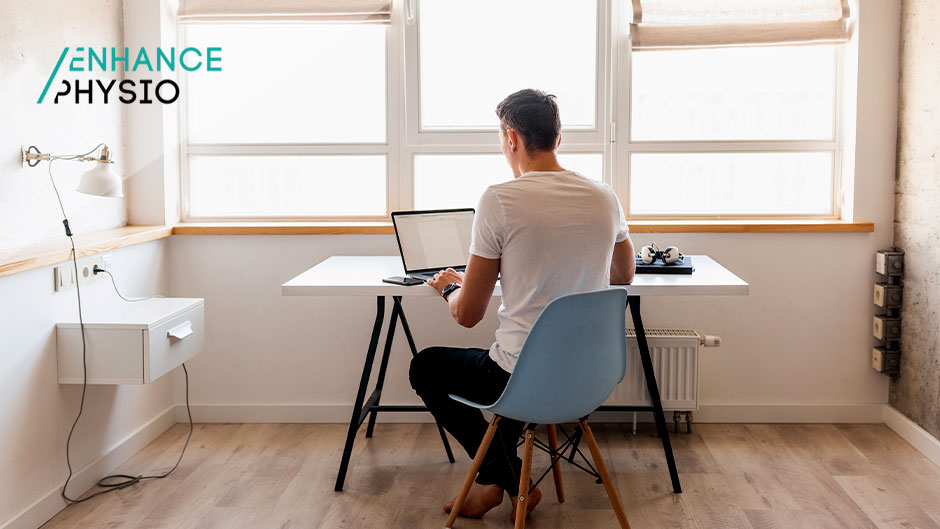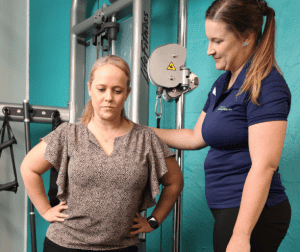According to Australian Productivity Commission statistics released in September 2021, around 40% of Australians now work from home, up from 8% before the pandemic.
As the world around us continues to change with COVID cases growing, it’s common for most people to revert to working from home. Whilst there are many pros and cons to working from home, the sudden and for some constant transition from office to home can cause a range of issues.
On average, an office worker could easily spend over 50% of the day sitting down, and moving to work from home will likely increase this amount. Along with the possibility of prolonged sitting, likely, some people don’t have the ideal set-up to mimic their workspace in the office and, as a result, may find themselves experiencing common injuries such as lower back pain, neck and shoulder pain and headaches.
Statistics on injuries sustained while working from home
Are you sitting at the kitchen table in a firm chair? Are you writing emails on the couch or in bed?
There is a reason why so much effort is put into keeping workplaces ergonomically safe. Whereas our office workspaces can be evaluated and examined by occupational health professionals, ergonomists, or health and safety officials within the organisation, the working from home mandate has largely disrupted this process, leaving many of us in the dark.
WorkCover Queensland approved over 100 claims from workers injured while working from home to the end of December 2021. Working-from-home injuries account for a modest proportion of total claims, with more than 65,000 claims accepted in 2020-2021. Fractures, occupational overuse injuries, soft tissue injuries, and back injuries were the most prevalent work-from-home injuries.

Injury prevention while working from home
Below are simple tips to assist you in avoiding working from home injuries and get the most out of your time working from home:
- The height of your screen, ideally the screen should be set up directly in front of you. Avoid extremes that require you to look up or down for long periods.
- Find a bench space that will allow you to rest your forearms to rest comfortably. Along with this, ensure that you have enough room for the keyboard and the mouse, avoid cramped benches and spaces if you can!
- Find a chair that suits you, one that’s comfortable and provides you with adequate support.
- Vary your posture throughout the day. This may be as simple as setting a timer as a reminder to get up and move throughout the day.
- When you feel uncomfortable, take that as a sign to get up and move.
- Check that the lighting level and location of the lighting fixtures are appropriate for the activity. The lighting level should be sufficient for visual work without causing eye strain.
- Ensure that you have adequate ventilation.
- Take the time to plan your day. More specifically, use your breaks wisely! Take them as an opportunity to complete a home workout or do something for yourself that you enjoy.
- Set limits around work hours – friends, family, and coworkers must be aware of your work schedule.
- Lastly, if in these trying times you find you’re struggling, remember that you’re very likely not alone. If you need support, please make no hesitation in contacting one of the following organisations or discussing concerns or the concerns of your loved ones with your GP.
- Lifeline Australia | 13 11 14
- Kids Helpline | 1800 55 1800
- MensLine Australia | 1300 78 99 78
- Suicide Call Back Service | 1300 659 467
- Beyond Blue | 1800 512 348
- Open Arms – Veterans & Families Counselling | 1800 011 046
Risks associated with working from home and their consequences
- Home accidents caused by physical injuries include slips, trips, and falls due to hazards in the home.
- Poor workstation set-up causing body stress injuries.
- Mental health issues are caused by long hours at work, lack of control over one’s schedule, and poor work-life balance.
- Reduced productivity.
- More absence from work.
- More injuries and increased workers’ comp costs.
Review Comcare and Safe Work Australia‘s advice on working from home. It includes information for managers and businesses.

Final thoughts on how to avoid working from home injuries
Sedentary behaviour increases the risk of musculoskeletal and other disorders in the body such as disc compression, muscular fatigue, poor posture, cardiovascular disease, some malignancies, and type II diabetes. Sitting for extended amounts of time can also lead to fatigue and decreased productivity.
Outside-of-work exercise does not necessarily nullify the dangerous aspects of extended sitting; thus, sitting must be interrupted frequently.
You may want to consult with one of our physiotherapists if you’re experiencing back, neck, or joint pain at work due to working from home.





